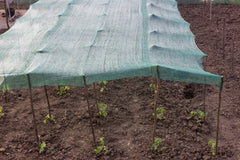How to choose the proper shade cloth?
How does choosing a proper shade cloth make a difference for your plants?
Gardening is a soothing and rewarding experience, when being done properly. To receive the best results, one must ensure proper conditions and environment for any living being to grow. For that, it is not enough to just supply soil, water and colorful pots for the plants, but also a real shelter. A big Green House is ideal, but expensive and not realistic in most cases. Therefore, securing your plants with a stark shade cloth, should do it for sure!
What is a shade cloth and how is it being used?
The shade cloth was developed a few decades ago, to help protect agriculture from the harsh climates in regions such as Australia, Middle East, Africa, and other extreme weather environments.
The actual use of a cloth to create shade is not new, but the technological appropriation for agricultural use has given farmers, and plant loving enthusiasts, the opportunity to grow almost anything, anywhere really. In summer, the cloth can be applied on to the skeleton of a greenhouse, protecting plants from unwanted heat and harmful direct sun light. In winter, shade cloth can be used as wind and dust protection. Of course, shade cloth can also protect other things like livestock, humans, pets and so on.

The shade cloth is made from specially made synthetic polyester, or even aluminum, making it super light but highly durable to sustain rain, dew, sprinkles, and other showers that might harm the plants, without loosing vital hydration.
Two types of shade cloth
There are two types of cloths: woven and knitted:
- Knitted cloth is made of lightweight polyethylene, which is being used for shade houses, greenhouses, and hot houses. The cloth is light, but resistant to tears, fraying and so on. Due to it's structure, knitted cloth is durable and flexible, making it resistible to most horticultural chemicals and detergents, so it has a longer life expectancy than a woven cloth.
- Woven cloth is Made of 100% polypropylene, allows more heat build up than knitted cloth, much heavier, UV protector so it is more suitable in sunny regions like deserts. The advantage of a woven cloth over the knitted cloth is that it can be used as a wind screen, solar protector, privacy provider, and as a patio shade.
Another factor for choosing a good shading cloth is its color. The greener the shade of color, the more protection from the sun it'll get. For example, 50% shade cloth in green color are good for nursery stock, pot plants, caladiums, lettuce and other plants that require partial shade. 75-80% green color cloth are more suitable for large trees, orchids, livestock, ferns and other beings that need dense shading.
shade of color, the more protection from the sun it'll get. For example, 50% shade cloth in green color are good for nursery stock, pot plants, caladiums, lettuce and other plants that require partial shade. 75-80% green color cloth are more suitable for large trees, orchids, livestock, ferns and other beings that need dense shading.
In conclusion, shade is vital for growth, just like the sun light. Proper shading cloth will insure proper growth.

